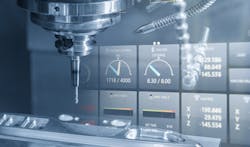Machine Shops Embrace AI for Superior Equipment Performance
Machine Learning devices and other types of Artificial Intelligence have significantly impacted manufacturing processes and outcomes, causing machinists to realize they can streamline their efforts with these technologies. Knowing how others have proceeded could encourage you to do the same.
Assessing and improving workflows
Since ML algorithms mimic the ways that humans learn, many machining professionals are interested in using them in their production processes to overcome bottlenecks and increase output. AI-based analytical tools can also highlight which services customers request most often, giving managers more insight into operations’ top revenue generators. When investing in new manufacturing technology, leaders can use what they have learned to make confident decisions.
AI can digest massive amounts of information, revealing patterns humans may otherwise miss. These new insights could help leaders solve problems before they become more expensive or time-consuming.
One manufacturing business collects machine condition reports in a database. If a laser heats up too quickly or there is excessive light in the beam profile, those issues could indicate that dirt in the machine is reflecting light. Keeping all those service reports in a database is an excellent first step in using ML tools to keep machines performing well without disruptions.
Similarly, AI can provide details about the average utilization times of specific machines. The statistics may reveal that a particular machine gets used much more frequently than another with identical capabilities, signaling that leaders should rebalance the workflow to prevent the oft-used machine from wearing out too quickly. Alternatively, machine shop professionals may use that data to remind themselves when certain machines need service appointments.
Streamlining service-related decisions
Technicians are instrumental for keeping fabrication equipment and accessories performing well. For example, people use cutting dies to create everything from packaging to apparel. Die maintenance involves examining the extent of natural wear, to determine whether a die will perform well after cleaning and lubrication, or if it’s time to replace it. People overseeing die management handle responsibilities such as creating an inventory of dies and establishing processes for operators to check accessories in and out.
Shop managers can apply AI to maintenance and management to detect particular details that humans may not spot. An ML algorithm may show that the cutting tools on a specific machine are wearing down faster than usual.
Whereas a human may assume that a performance problem has to do with the equipment, a closer examination prompted by AI-backed data could show that premature degradation only began once a specific employee started using the machine. That outcome would suggest the operator needs more training or other corrective actions.
Similarly, AI can improve die management by showing people how overall usage or other variable parameters affect supply restocking. Then, people can make decisions based on data. Statistics show age-related equipment degradation causes only 11% of failures. That means the contributors are more complex than industrial professionals may expect. Many preventive maintenance programs require technicians to replace parts at specific usage-based intervals. That is a good start, but it may not be comprehensive. AI can fill in the gaps.
Improving overall visibility
Well-trained ML algorithms can warn people of problems before machines show obvious symptoms. Operators still play an important role in examining equipment before and after they start using it. Those thorough checks ensure severe issues do not go unaddressed for too long. However, AI can support those inspections by picking up on abnormal aspects that may be too slight for humans to notice immediately, such as high temperatures or excessive vibration.
One AI-based product for industrial equipment assigns a health score on a 100-point scale after continuously analyzing data from connected sensors with algorithms working in the background. The software monitors machines in real time, allowing managers, technicians and other responsible parties to get relevant data.
Equipment-specific scores are especially valuable because they provide snapshots that help people determine which machines to prioritize in the repair schedule or stop using if the flagged problem is too severe.
Those details are ideal for personnel visiting several machine shops each workday. Although some facilities have technicians who work only on the machines in one location, another common approach is to have all equipment of a certain brand serviced by a specialist with in-depth training. In those cases, the maintenance expert could make numerous field calls in a given week based on their coverage area.
Pulling up a dashboard and seeing various machine health scores could inform them where to stop first and which repairs may be especially intensive. Additionally, those insights could require them to reschedule the less demanding ones.
About the Author
Emily Newton
Emily Newton is the Editor-in-Chief of Revolutionized, an online magazine exploring the latest industrial innovations.
